The Eureka State of California has almost every ecosystem imaginable in one state. With oceans, forests, and deserts, any kind of creature can thrive in California. This makes it fertile ground for 8 distinct species of Hummingbirds that fly its coasts and islands.
Read on to learn about these amazing creatures and how to spot each one in the wild. We’ll also tell you about the best ways to distinguish them, as well as some things about their behavior and habitat.
Types of Hummingbirds in California
Let’s introduce you to the types of hummingbirds you’ll be seeing in California. Scroll down to read more details about each one, and learn how to spot them!
- Allen’s Hummingbird – Selasphorus sasin
- Black-chinned Hummingbird – Archilochus alexandri
- Rufous Hummingbird – Selasphorus rufus
- Costa’s Hummingbird – Calypte costae
- Broad-tailed Hummingbird – Selasphorus platycercus
- Broad-billed Hummingbird – Cynanthus latirostris
- Anna’s Hummingbird – Calypte anna
- Calliope Hummingbird – Selasphorus calliope
Allen’s Hummingbird – Selasphorus sasin
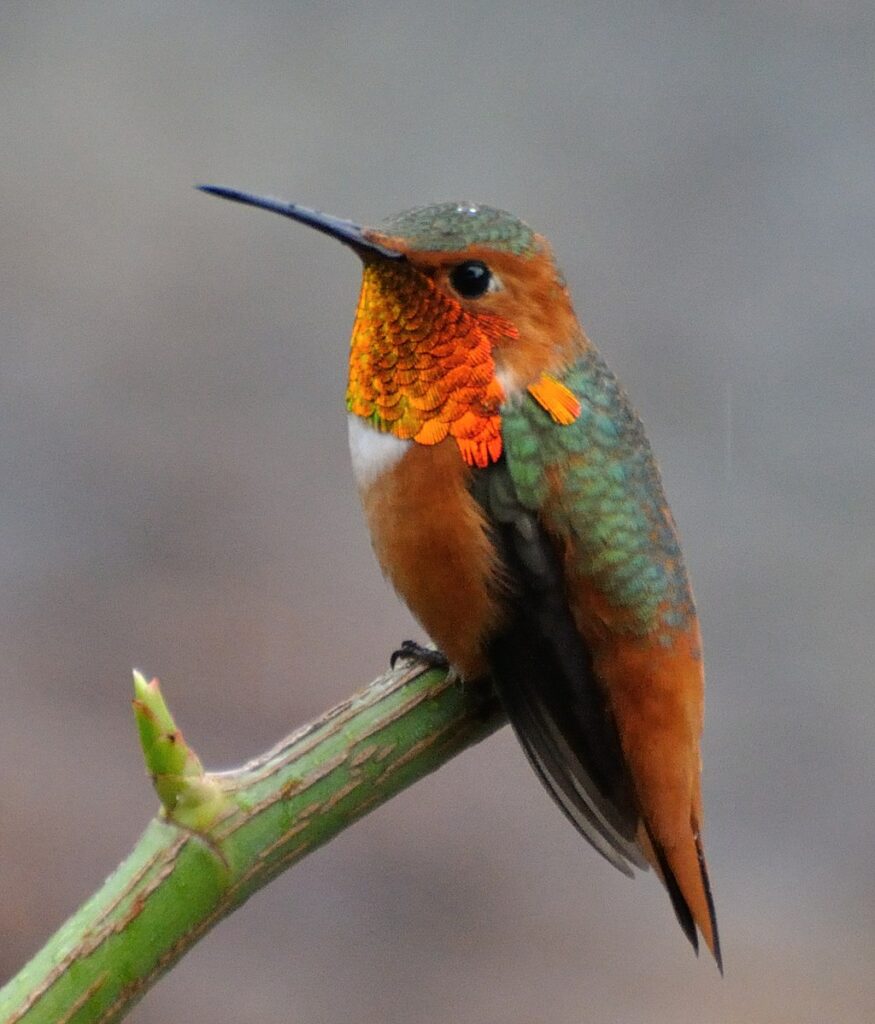
Allen’s Hummingbirds are beautiful and vibrant birds that reside on the California coast.
Coloration and Markings: Allen’s Hummingbirds are beautiful and brightly colored. As with most birds, the males have more striking markings. They have green and black foreheads, with rust colored flanks and tails. Most noticeably, their throats are iridescent orange-red. The females and young have similar coloring, but instead of orange, have speckled throats. They are mostly green and only feature the rust color on their tales, which are white-tipped.
Size: Grown adult Allen’s Hummingbirds grow to 3-3.5 inches in length and have a wingspan of about 4.3 inches.
Habitat: These birds are found mostly in brushy woods, gardens, and meadows across the California coast. They mostly stay in California but can be found as far north as the top of Oregon.
More About Allen’s Hummingbird
Allen’s Hummingbirds look very similar to Rufous Hummingbirds, and they are often confused. The major difference is the narrow outer tail feathers in the female and young Allen’s.
They spend winter in Mexico before they migrate up the California coast in the warmer months.
Black-chinned Hummingbird – Archilochus alexandri

Black-chinned Hummingbirds are lively birds who occupy large swathes of the California coast between March and October.
Coloration and Markings: Black-chinned Hummingbirds get their names from the black throats of the males, which also have an iridescent purple base. The rest of their bodies are metallic gray and white. Female Black-chinned Hummingbirds have a white throat and tail feathers with white tips. They do not have the black and purple throats of their male counterparts.
Size: Black-chinned Hummingbirds are approximately 3.5 inches in length and weigh only .2 ounces. Their wingspan stretches 4.3 inches.
Habitat: Black-chinned Hummingbirds spend part of their time inland in western states to breed. They are migratory and move South to Mexico and the Gulf Coast in the winter.
More About the Black-chinned Hummingbird
While most hummingbirds eat only nectar, Black-chinned Hummingbirds also eat small insects and even spiders. They also use spider silk to reinforce the plant down that makes up their nests.
Rufous Hummingbird – Selasphorus rufus
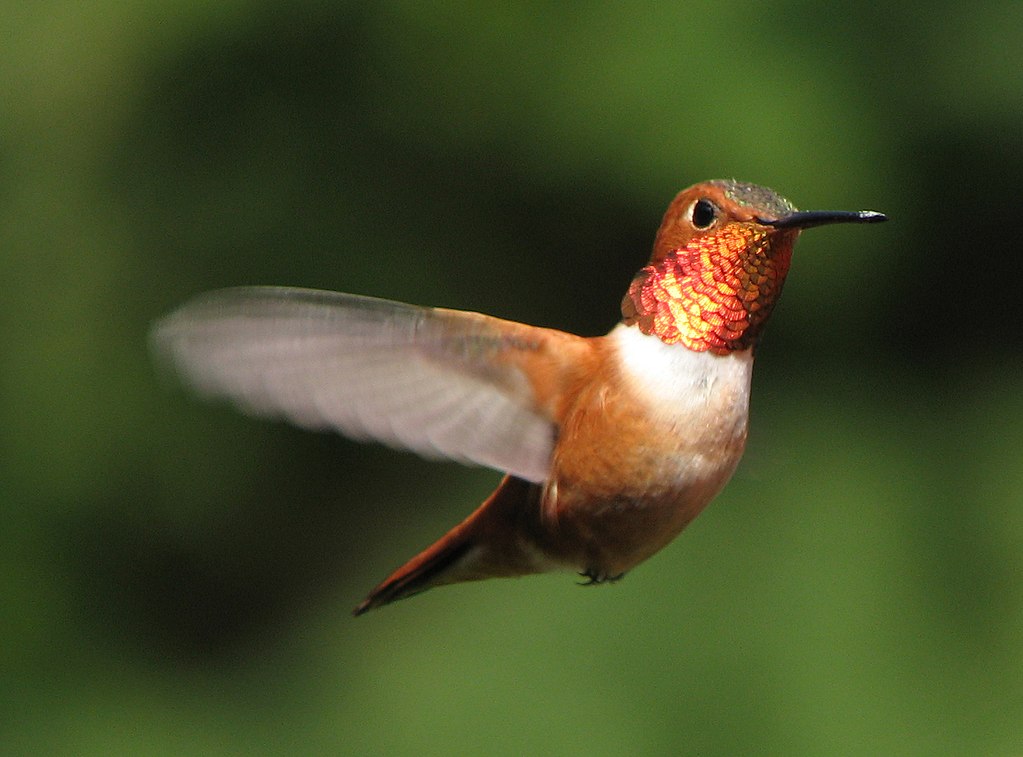
Rufous Hummingbirds are bright and sprightly birds that are just as colorful as the flowers they feed on.
Coloration and Markings: Rufous Hummingbirds are often confused with the similarly colored Allen’s Hummingbirds. They are bright orange all over, with a white patch below the throat. The males have an iridescent red patch in the middle of their throats.
Size: Rufous Hummingbirds are some of the smallest of their counterparts, usually under 3 inches in length and with a wingspan of 4.3 inches.
Habitat: Rufous Hummingbirds have some of the longest migrations of any hummingbird species relative to their size. They travel upwards of 4,000 miles each way, from northwest Alaska all the way to the Gulf Coast and Mexico during the winter.
More About the Rufous Hummingbird
Rufous Hummingbirds are one of the most aggressive species of hummingbirds despite their size and will chase off much larger hummingbirds, especially during their migrations.
Costa’s Hummingbird – Calypte costae
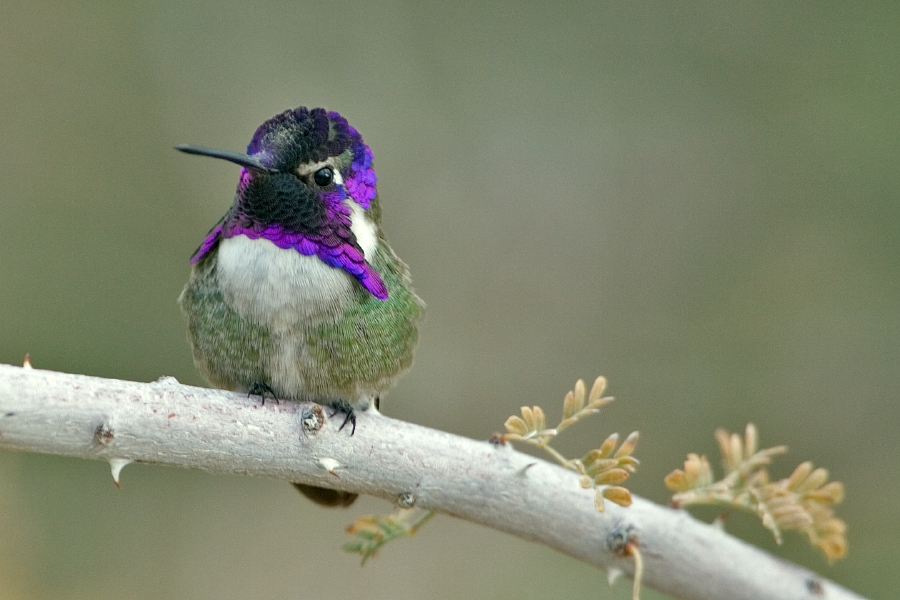
Costa’s Hummingbirds are vibrant desert-dwelling birds that are instantly recognizable.
Coloration and Markings: Costa’s Hummingbirds are striking at first glance. They have iridescent purple throats that flare out along their chest and an equally bright purple crown. They have bright green backs to offset the purple, which fade into white on their stomachs. Female Costa’s do not have the eye-catching purple of their male counterparts, but they do have the same green backs and white fronts.
Size: Costa’s Hummingbirds are one of the smaller California hummingbirds. They do not reach more than 3.5 inches in length or 0.1 oz in weight.
Habitat: Costa’s Hummingbirds reside mostly in the deserts around Baja, California, and Southwest Arizona. They can be seen as far north as Utah and Nevada during the breeding season.
More About Costa’s Hummingbird
Costa’s Hummingbirds build their nests low to the ground, unlike most other hummingbirds, at most seven feet off the ground. They usually build in shrubs in the middle of the desert or deciduous forest.
Broad-tailed Hummingbird – Selasphorus platycercus
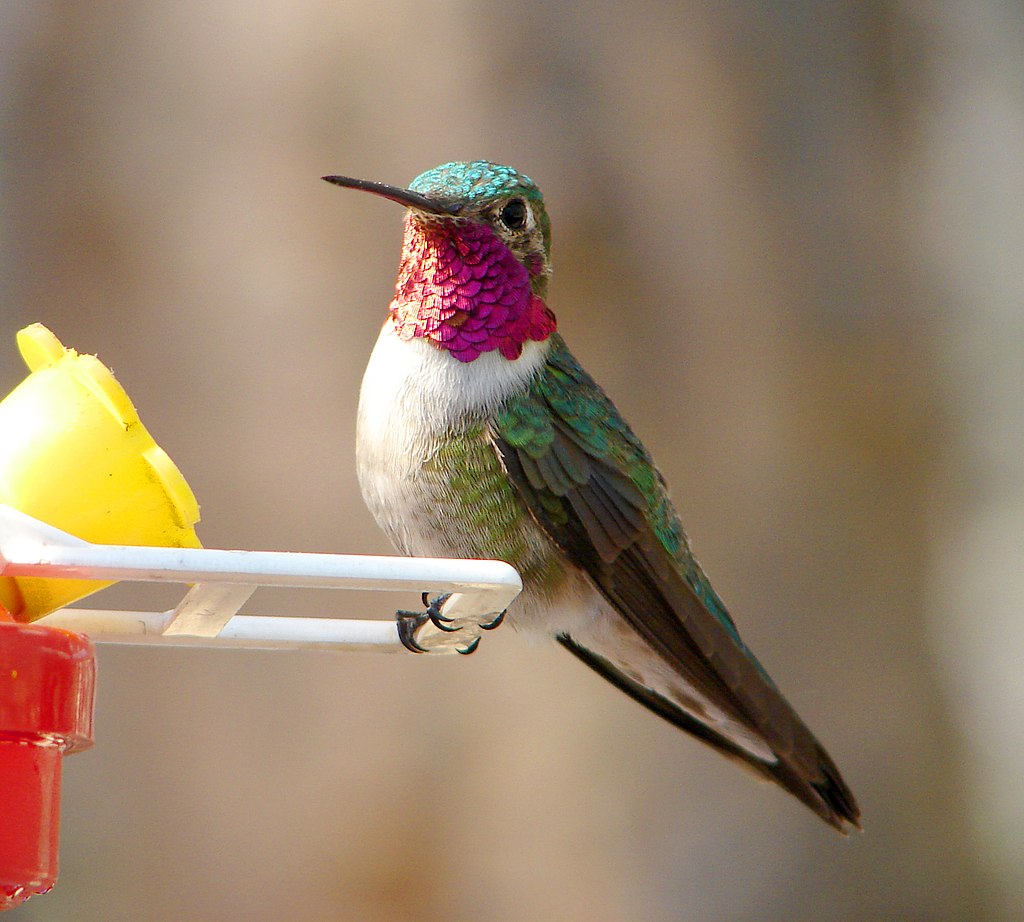
Broad-tailed Hummingbirds are desert-dwelling birds that reside in some of the highest elevated areas in the Southwest.
Coloration and Markings: Broad-tailed Hummingbirds are so named for their rounded black tail that protrudes beyond their wingspan, which is unique among hummingbird species. The male Broad-tails have a bright rose-red patch on their throat. Apart from this patch, males and females look similar, with an iridescent green back and a white ring around their eyes.
Size: Broad-tailed Hummingbirds are one of the larger California hummingbird species, with a wingspan of 5.25 inches, and a length of over 4 inches.
Habitat: Broad-tailed Hummingbirds spend their breeding season in high meadows and woodlands, at elevations sometimes reaching 10,000 feet. These elevations are only found in the mountains of Northwest California. After the breeding season, these birds migrate south to Mexico for the winter.
More about the Broad-tailed Hummingbird
Because the high elevation where these hummingbirds live can get very cold, the Broad-tailed Hummingbird can slow down its heart rate to accommodate the temperature. This is highly unusual since most hummingbirds are known for their incredibly fast heart rates.
Broad-billed Hummingbird – Cynanthus latirostris

Broad-billed Hummingbirds usually spend their time south of California, so when you spot one along the golden coast, it’s a real treat.
Coloration and Markings: Almost all hummingbirds are known for their vibrant colors and exciting markings but the Broad-billed hummingbird is even more special. The males are a deep, metallic green all over their bodies and even down their wings and tails. Both males and females have long, bright red beaks.
Size: Broad-billed hummingbirds reach an average length of about 3.5 inches, with a wingspan of about 4 inches.
Habitat: Most Broad-billed Hummingbirds spend all year in central Mexico and sometimes along the Mexican Pacific coast. Rather than migrate north and south, they usually prefer to spend all year in the warmth.
More About the Broad-billed Hummingbird
Broad-billed Hummingbirds build their nests low to the ground, and generally spend time near sea level, in canyon streams and meadows. Therefore, the ones that do reach California will be very tempted by backyard feeders.
Anna’s Hummingbird – Calypte anna

Anna’s Hummingbirds are some of the easiest to spot in California, but that doesn’t make them any less brilliant.
Coloration and Markings: Anna’s Hummingbirds are mostly green and gray, with gradients of these colors stretching around their bodies. The males are most noticeable, with stunning magenta heads that stretch all the way down their necks.
Size: Anna’s Hummingbirds have an average length of just under 4 inches, with a wingspan of just under five inches.
Habitat: These pink hummingbirds are ubiquitous in the state because they usually do not migrate. They generally stay along California’s entire Pacific coast and are the most common hummingbird in that region.
More About Anna’s Hummingbird
Anna’s Hummingbirds are easiest to spot during the breeding season since the males perform dramatic dives during courtship. Each bird will climb upwards of 130 feet into the air and then swoop directly down to attract a mate.
Calliope Hummingbird – Selasphorus calliope
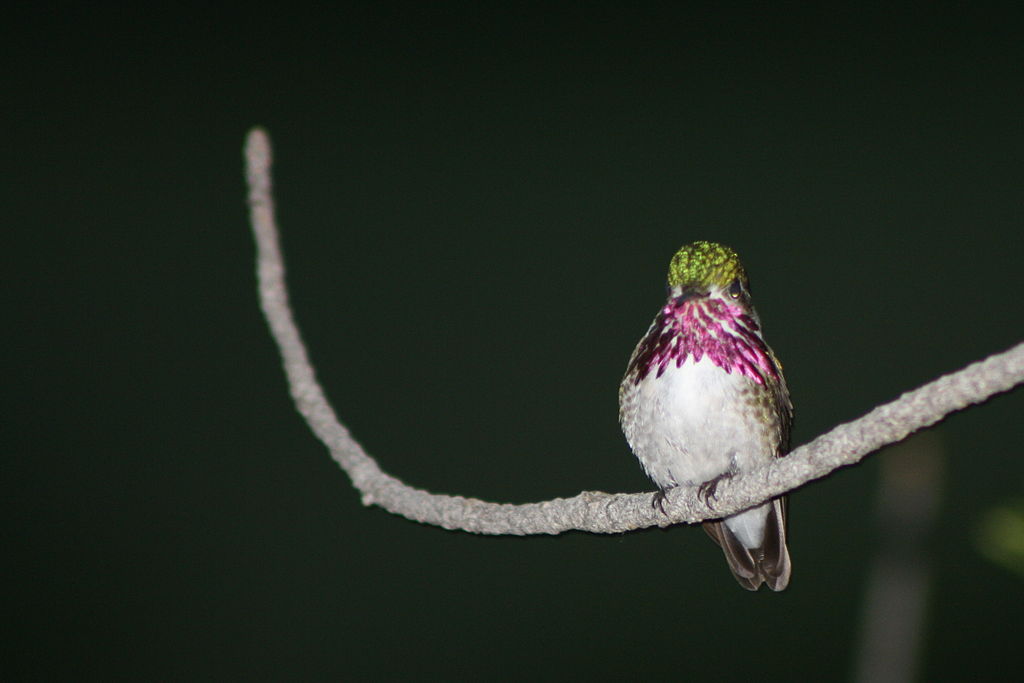
Calliope Hummingbirds are bay-area beauties that can be spotted up north during their migrations.
Coloration and Markings: Calliope Hummingbirds have more neutral colors than most hummingbirds, although males still have a small but vibrant magenta patch on their throats, known as a gorget. Both males and females have glossy black and green feathers on their backs and dark tails.
Size: Calliope Hummingbirds are the smallest birds in the entire United States. They have an average length of just 3.1 inches and a wingspan of just over 4 inches.
Habitat: Calliope Hummingbirds are one of the most northern-dwelling hummingbird species, starting along the Pacific coast of California and traveling as far north as Canada during the spring and summer. Mostly, they can be found in northern California and Oregon on their way up, and along the Rocky Mountains on their way back South.
More about the Calliope Hummingbird
Although they are the smallest birds in the USA, Calliope Hummingbirds are fierce when it comes to defending their territory, and have been known to beat back red-tailed hawks from their nests.
